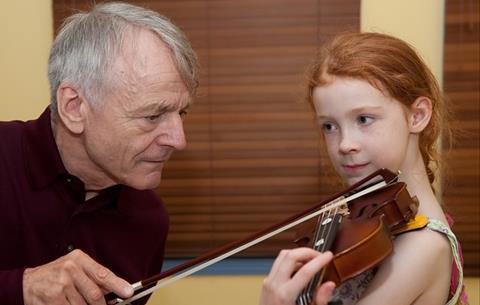Géza Szilvay, co-founder of the Colourstrings method, gives advice for how a teacher should approach the very first violin lesson with a young beginner student

Explore more teaching guides in our Education Hub
1. Keep both hands active from the beginning
When you start to teach the violin to a child, bear in mind that both their hands should be active from the very first lesson. Otherwise, the idle hand can create tension in the active hand. A child can concentrate consciously on only one new thing at a time, and during the first lesson it should be the violin hold. The teacher should assist the bow hold and movement so that the child experiences it unconsciously.
2. The violin hold will feel unnatural to a child – be patient
The main attention is focused on the violin hold at the beginning because the position is so unnatural. It is the demanding task – duty even – of the teacher to make this unnatural position seem natural. Pedagogues working with beginners must develop a technique for moulding this basic hold. This manual activity is like the work of a physiotherapist and it is not restricted to the first lessons – it usually lasts several months, until the child feels that the violin is an extension of their body.
3. Left hand pizzicato helps naturally introduce good left hand position and first contact with the strings
The teacher should mould the child’s violin hold with their own right hand. When the child understands that the head is heavy enough to hold the instrument by its own weight without chin pressure, the teacher may put the child’s left hand on the fingerboard, around third or fourth position. Encourage the child to pluck the strings using left-hand pizzicato. With the four fingers above the four strings, the pupil can use all the fingers to pluck open strings. Try to avoid naming the fingers with numbers, though. So, the ‘pointing’ (first) finger should pluck the G string, the ‘long’ (second) finger the D string, the ‘ring’ (third) finger the A string and the ‘pinkie’ (fourth) the E string.
4. The teacher introduces the bow
While the child’s left-hand fingers pluck the strings using various rhythms, tempos and dynamics (with the teacher’s right hand still helping the violin hand of the child), the rhythm that the child is plucking should be imitated with a bow-stroke movement in the air above the strings. I recommend long movements in order to feel the down- and up-bow directions. At the beginning the child should not be holding the bow, so that they can concentrate on experiencing the bow-stroke movement.
5. Now let the pupil try bowing, but support both hands throughout
When the bow is then given to the child, the hold should not be a proper one. Let the child hold it in their palm, in what Sándor Végh called the ‘monkey hold’ – gentle and relaxed. Assistance should be given so gently and cleverly that the child might imagine they are playing alone. Praise them after each stroke. This is not cheating. The first lesson must be enjoyed, and the child should be proud that they can produce sounds from the violin by themselves.
6. As soon as possible, establish a connection between the two hands
To optimise the first lesson, the next step should be to connect the movements of the two hands. Help the child to touch a string with one finger (usually the E string with the fourth finger) in the middle of the fingerboard. This soft string-touching movement in the left hand creates a gentle, relaxed feeling in the right hand, whereas teaching a strong stopping movement too early can create rigidity in the right hand.
7. Never underestimate the importance of making your pupil smile
Connect this left-hand string-touching movement with a teacher-assisted bow-stroke movement on the string. The natural harmonic will sound like magic. Repeat this several times on each string, playing it soft and loud, fast and slow, gentle and harsh, sad and happy, wild and mysterious. The little violinist will smile.
A version of this article was first published as part of the Teacher Talk series in The Strad in January 2011











































2 Readers' comments